2019 KIA SPORTAGE engine oil
[x] Cancel search: engine oilPage 504 of 607
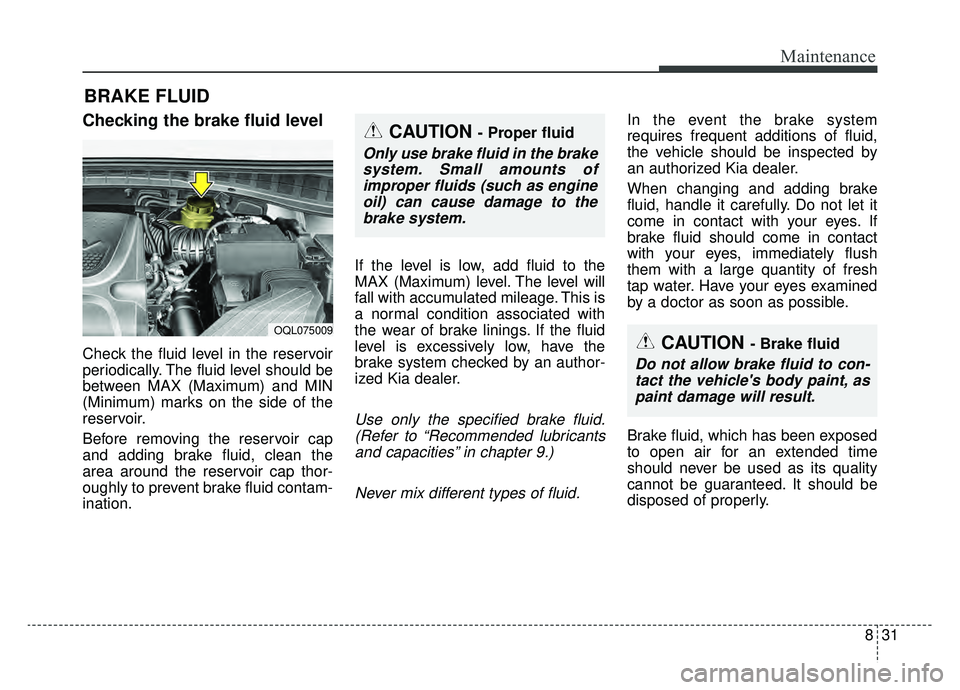
831
Maintenance
BRAKE FLUID
Checking the brake fluid level
Check the fluid level in the reservoir
periodically. The fluid level should be
between MAX (Maximum) and MIN
(Minimum) marks on the side of the
reservoir.
Before removing the reservoir cap
and adding brake fluid, clean the
area around the reservoir cap thor-
oughly to prevent brake fluid contam-
ination.If the level is low, add fluid to the
MAX (Maximum) level. The level will
fall with accumulated mileage. This is
a normal condition associated with
the wear of brake linings. If the fluid
level is excessively low, have the
brake system checked by an author-
ized Kia dealer.
Use only the specified brake fluid.
(Refer to “Recommended lubricantsand capacities” in chapter 9.)
Never mix different types of fluid.
In the event the brake system
requires frequent additions of fluid,
the vehicle should be inspected by
an authorized Kia dealer.
When changing and adding brake
fluid, handle it carefully. Do not let it
come in contact with your eyes. If
brake fluid should come in contact
with your eyes, immediately flush
them with a large quantity of fresh
tap water. Have your eyes examined
by a doctor as soon as possible.
Brake fluid, which has been exposed
to open air for an extended time
should never be used as its quality
cannot be guaranteed. It should be
disposed of properly.
OQL075009CAUTION - Brake fluid
Do not allow brake fluid to con-tact the vehicle's body paint, aspaint damage will result.
CAUTION - Proper fluid
Only use brake fluid in the brakesystem. Small amounts ofimproper fluids (such as engineoil) can cause damage to thebrake system.
Page 532 of 607
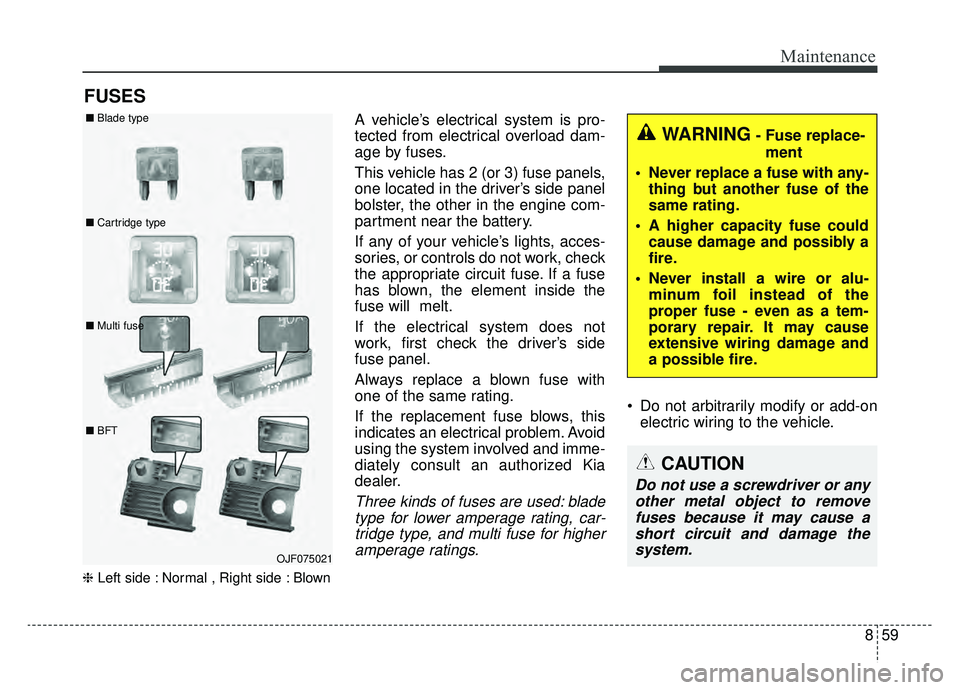
859
Maintenance
FUSES
❈Left side : Normal , Right side : Blown
A vehicle’s electrical system is pro-
tected from electrical overload dam-
age by fuses.
This vehicle has 2 (or 3) fuse panels,
one located in the driver’s side panel
bolster, the other in the engine com-
partment near the battery.
If any of your vehicle’s lights, acces-
sories, or controls do not work, check
the appropriate circuit fuse. If a fuse
has blown, the element inside the
fuse will melt.
If the electrical system does not
work, first check the driver’s side
fuse panel.
Always replace a blown fuse with
one of the same rating.
If the replacement fuse blows, this
indicates an electrical problem. Avoid
using the system involved and imme-
diately consult an authorized Kia
dealer.
Three kinds of fuses are used: blade
type for lower amperage rating, car-tridge type, and multi fuse for higheramperage ratings.
Do not arbitrarily modify or add-on electric wiring to the vehicle.
WARNING- Fuse replace-
ment
Never replace a fuse with any- thing but another fuse of the
same rating.
A higher capacity fuse could cause damage and possibly a
fire.
Never install a wire or alu- minum foil instead of the
proper fuse - even as a tem-
porary repair. It may cause
extensive wiring damage and
a possible fire.
CAUTION
Do not use a screwdriver or anyother metal object to removefuses because it may cause ashort circuit and damage thesystem.
OJF075021
■
Blade type
■ Cartridge type
■ Multi fuse
■ BFT
Page 566 of 607
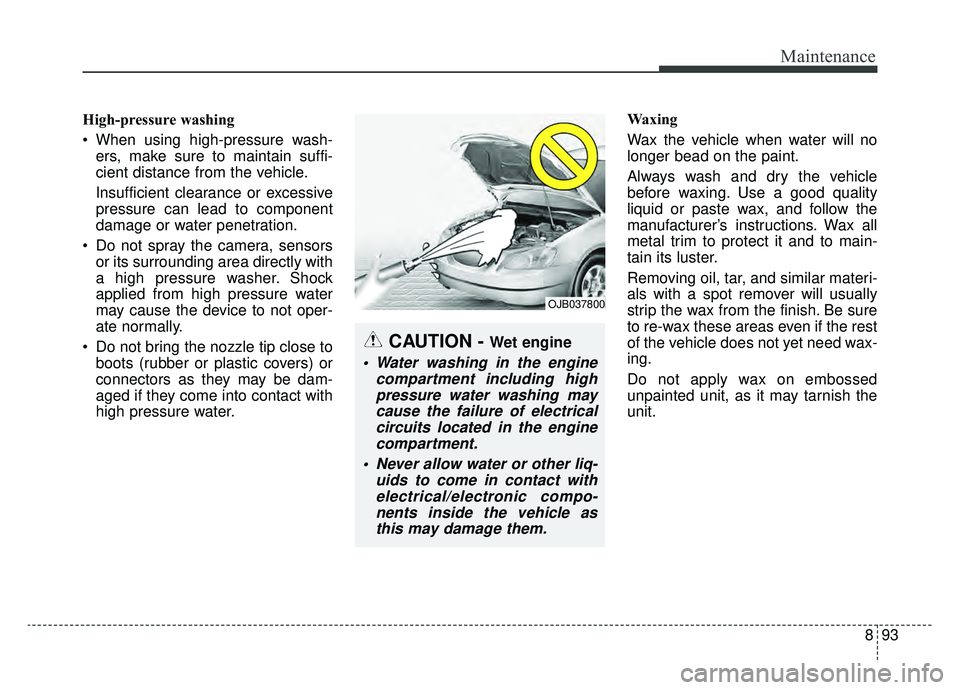
893
Maintenance
High-pressure washing
When using high-pressure wash-ers, make sure to maintain suffi-
cient distance from the vehicle.
Insufficient clearance or excessive
pressure can lead to component
damage or water penetration.
Do not spray the camera, sensors or its surrounding area directly with
a high pressure washer. Shock
applied from high pressure water
may cause the device to not oper-
ate normally.
Do not bring the nozzle tip close to boots (rubber or plastic covers) or
connectors as they may be dam-
aged if they come into contact with
high pressure water. Waxing
Wax the vehicle when water will no
longer bead on the paint.
Always wash and dry the vehicle
before waxing. Use a good quality
liquid or paste wax, and follow the
manufacturer’s instructions. Wax all
metal trim to protect it and to main-
tain its luster.
Removing oil, tar, and similar materi-
als with a spot remover will usually
strip the wax from the finish. Be sure
to re-wax these areas even if the rest
of the vehicle does not yet need wax-
ing.
Do not apply wax on embossed
unpainted unit, as it may tarnish the
unit.
OJB037800
CAUTION - Wet engine
Water washing in the engine
compartment including highpressure water washing maycause the failure of electricalcircuits located in the enginecompartment.
Never allow water or other liq- uids to come in contact withelectrical/electronic compo-nents inside the vehicle asthis may damage them.
Page 583 of 607
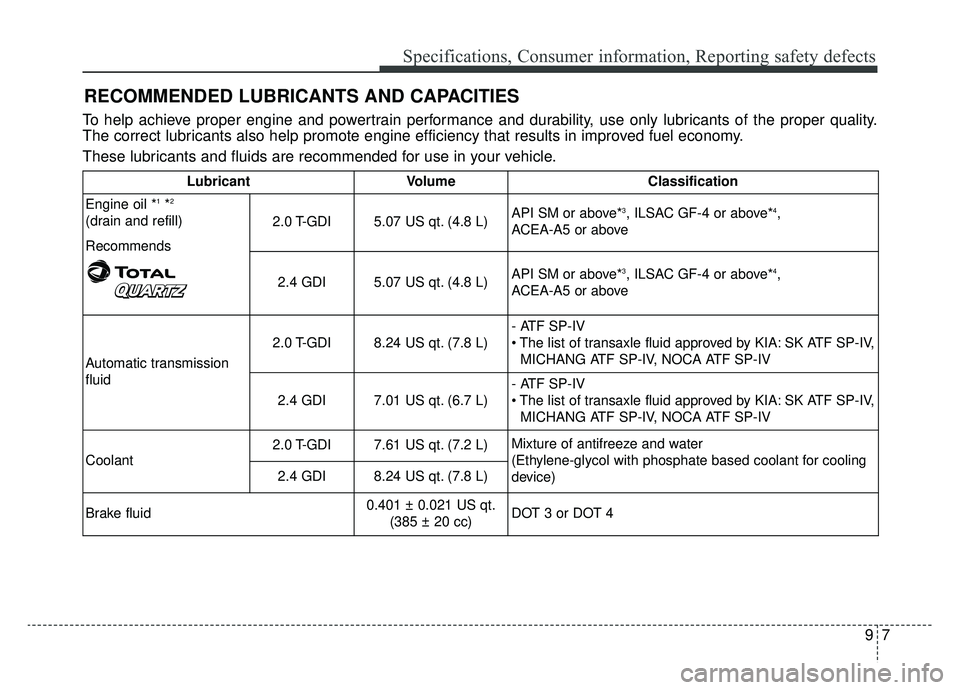
97
Specifications, Consumer information, Reporting safety defects
RECOMMENDED LUBRICANTS AND CAPACITIES
To help achieve proper engine and powertrain performance and durability, use only lubricants of the proper quality.
The correct lubricants also help promote engine efficiency that results in improved fuel economy.
These lubricants and fluids are recommended for use in your vehicle.
LubricantVolumeClassification
Engine oil *
1*2
(drain and refill)
Recommends 2.0 T-GDI5.07 US qt. (4.8 L)
API SM or above*3, ILSAC GF-4 or above*4,
ACEA-A5 or above
2.4 GDI
5.07 US qt. (4.8 L) API SM or above*3, ILSAC GF-4 or above*4,
ACEA-A5 or above
Automatic transmission
fluid 2.0 T-GDI
8.24 US qt. (7.8 L)
- ATF SP-IV
• The list of transaxle fluid approved by KIA: SK ATF SP-IV,
MICHANG ATF SP-IV, NOCA ATF SP-IV
2.4 GDI
7.01 US qt. (6.7 L) - ATF SP-IV
SK ATF SP-IV,
MICHANG ATF SP-IV, NOCA ATF SP-IV
Coolant 2.0 T-GDI
7.61 US qt. (7.2 L)
Mixture of antifreeze and water
(Ethylene-glycol with phosphate based coolant for cooling
device)
2.4 GDI
8.24 US qt. (7.8 L)
Brake fluid
0.401 ± 0.021 US qt. (385 ± 20 cc) DOT 3 or DOT 4
Page 584 of 607
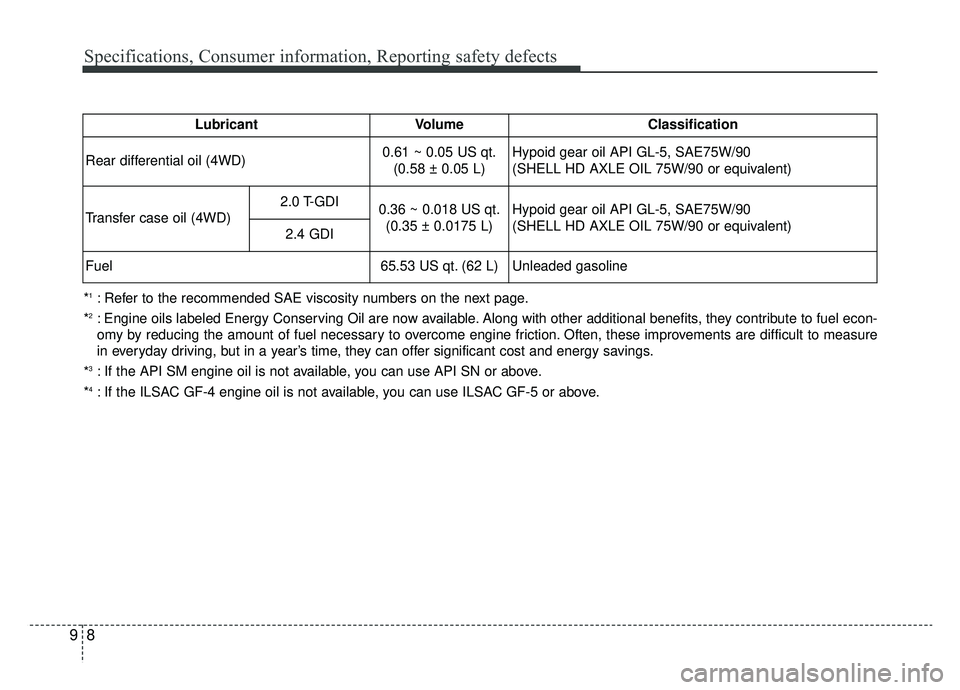
Specifications, Consumer information, Reporting safety defects
89
*1: Refer to the recommended SAE viscosity numbers on the next page.
*
2: Engine oils labeled Energy Conserving Oil are now available. Along with other additional benefits, they contribute to fuel econ-
omy by reducing the amount of fuel necessary to overcome engine friction. Often, these improvements are difficult to measure
in everyday driving, but in a year’s time, they can offer significant cost and energy savings.
*
3: If the API SM engine oil is not available, you can use API SN or above.
*
4: If the ILSAC GF-4 engine oil is not available, you can use ILSAC GF-5 or above. Lubricant
Volume
Classification
Rear differential oil (4WD)
0.61 ~ 0.05 US qt. (0.58 ± 0.05 L) Hypoid gear oil API GL-5, SAE75W/90
(SHELL HD AXLE OIL 75W/90 or equivalent)
Transfer case oil (4WD) 2.0 T-GDI
0.36 ~ 0.018 US qt.
(0.35 ± 0.0175 L) Hypoid gear oil API GL-5, SAE75W/90
(SHELL HD AXLE OIL 75W/90 or equivalent)
2.4 GDI
Fuel
65.53 US qt. (62 L) Unleaded gasoline
Page 585 of 607
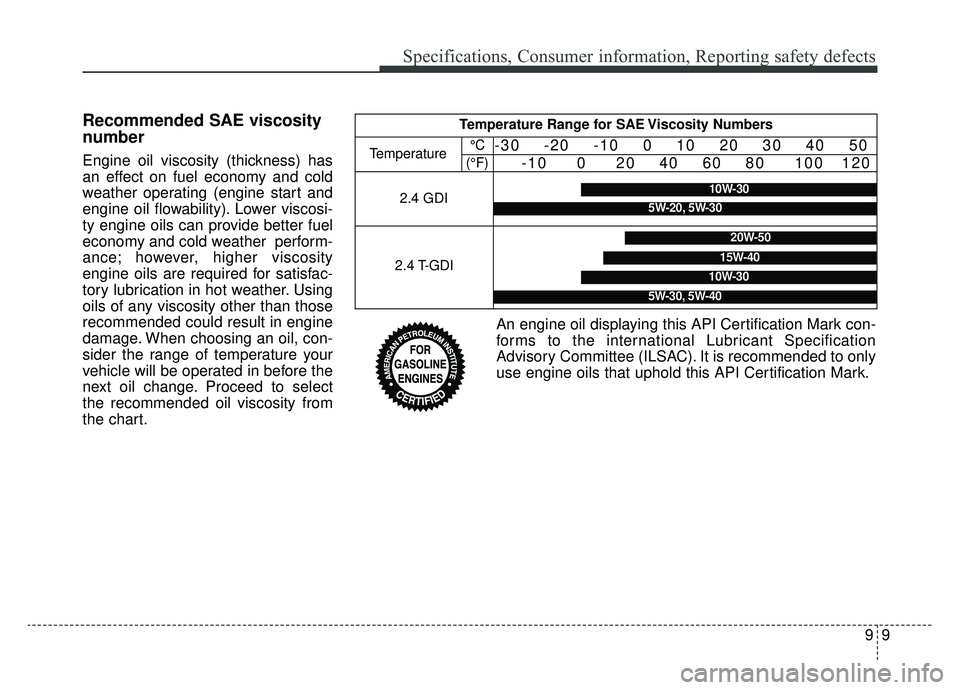
99
Specifications, Consumer information, Reporting safety defects
Recommended SAE viscosity
number
Engine oil viscosity (thickness) has
an effect on fuel economy and cold
weather operating (engine start and
engine oil flowability). Lower viscosi-
ty engine oils can provide better fuel
economy and cold weather perform-
ance; however, higher viscosity
engine oils are required for satisfac-
tory lubrication in hot weather. Using
oils of any viscosity other than those
recommended could result in engine
damage. When choosing an oil, con-
sider the range of temperature your
vehicle will be operated in before the
next oil change. Proceed to select
the recommended oil viscosity from
the chart.
Temperature Range for SAE Viscosity Numbers
Temperature°C
(°F)-30 -20 -10 0 10 20 30 40 50 -10 0 20 40 60 80 100 120
2.4 T-GDI
20W-50
10W-30
15W-40
5W-30, 5W-40
2.4 GDI10W-30
5W-20, 5W-30
An engine oil displaying this API Certification Mark con-
forms to the international Lubricant Specification
Advisory Committee (ILSAC). It is recommended to only
use engine oils that uphold this API Certification Mark.
Page 597 of 607
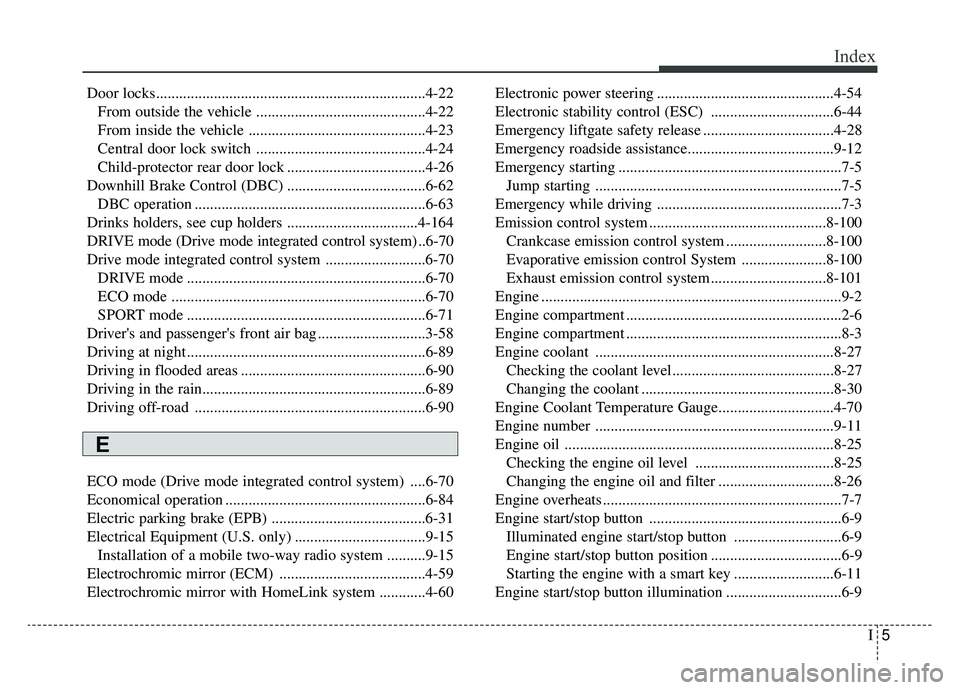
I5
Index
Door locks......................................................................4-\
22From outside the vehicle ............................................4-22
From inside the vehicle ..............................................4-23
Central door lock switch ............................................4-24
Child-protector rear door lock ....................................4-26
Downhill Brake Control (DBC) ....................................6-62 DBC operation ............................................................6-63
Drinks holders, see cup holders ..................................4-164
DRIVE mode (Drive mode integrated control system) ..6-70
Drive mode integrated control system ..........................6-70 DRIVE mode ..............................................................6-70
ECO mode ..................................................................6-70
SPORT mode ..............................................................6-71
Driver's and passenger's front air bag ............................3-58
Driving at night ..............................................................6-89
Driving in flooded areas ................................................6-90
Driving in the rain..........................................................6-89
Driving off-road ............................................................6-90
ECO mode (Drive mode integrated control system) ....6-70
Economical operation ....................................................6-84
Electric parking brake (EPB) ........................................6-31
Electrical Equipment (U.S. only) ..................................9-15 Installation of a mobile two-way radio system ..........9-15
Electrochromic mirror (ECM) ......................................4-59
Electrochromic mirror with HomeLink system ............4-60 Electronic power steering ..............................................4-54
Electronic stability control (ESC) ................................6-44
Emergency liftgate safety release ..................................4-28
Emergency roadside assistance......................................9-12
Emergency starting ..........................................................7-5
Jump starting ................................................................7-5
Emergency while driving ................................................7-3
Emission control system ..............................................8-100 Crankcase emission control system ..........................8-100
Evaporative emission control System ......................8-100
Exhaust emission control system ..............................8-101
Engine ........................................................................\
......9-2
Engine compartment ........................................................2-6
Engine compartment ........................................................8-3
Engine coolant ..............................................................8-27 Checking the coolant level..........................................8-27
Changing the coolant ..................................................8-30
Engine Coolant Temperature Gauge..............................4-70
Engine number ..............................................................9-11
Engine oil ......................................................................8-\
25 Checking the engine oil level ....................................8-25
Changing the engine oil and filter ..............................8-26
Engine overheats ..............................................................7-7
Engine start/stop button ..................................................6-9 Illuminated engine start/stop button ............................6-9
Engine start/stop button position ..................................6-9
Starting the engine with a smart key ..........................6-11
Engine start/stop button illumination ..............................6-9
E
Page 598 of 607
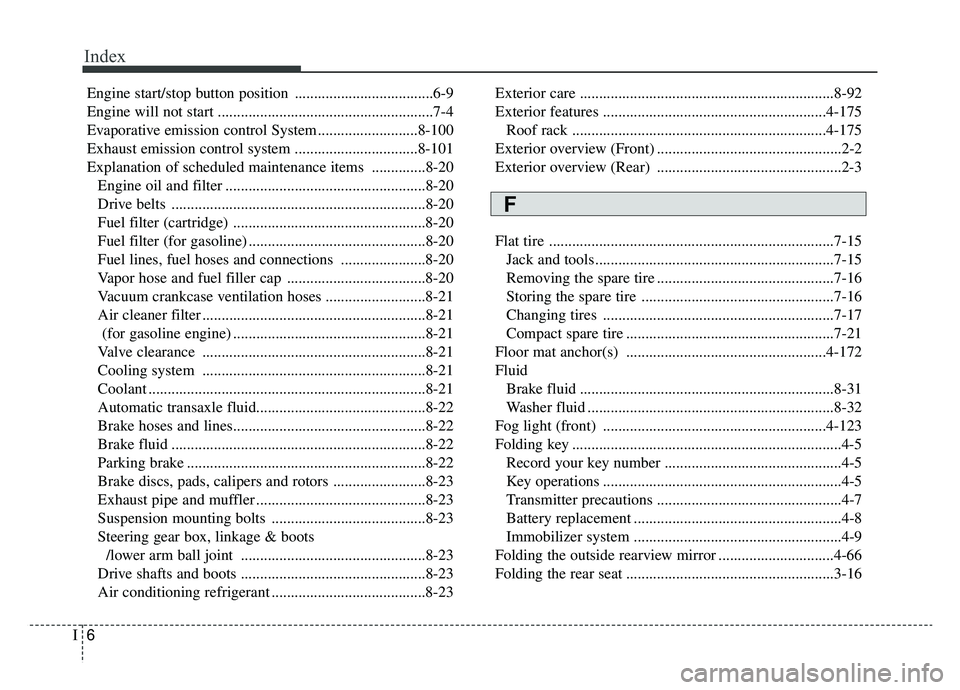
Index
6I
Engine start/stop button position ....................................6-9
Engine will not start ........................................................7-4
Evaporative emission control System ..........................8-100
Exhaust emission control system ................................8-101
Explanation of scheduled maintenance items ..............8-20Engine oil and filter ....................................................8-20
Drive belts ..................................................................8-20
Fuel filter (cartridge) ..................................................8-20
Fuel filter (for gasoline) ..............................................8-20
Fuel lines, fuel hoses and connections ......................8-20
Vapor hose and fuel filler cap ....................................8-20
Vacuum crankcase ventilation hoses ..........................8-21
Air cleaner filter ..........................................................8-21(for gasoline engine) ..................................................8-21
Valve clearance ..........................................................8-21
Cooling system ..........................................................8-21
Coolant ........................................................................\
8-21
Automatic transaxle fluid............................................8-2\
2
Brake hoses and lines..................................................8-22
Brake fluid ..................................................................8-22
Parking brake ..............................................................8-22
Brake discs, pads, calipers and rotors ........................8-23
Exhaust pipe and muffler ............................................8-23
Suspension mounting bolts ........................................8-23
Steering gear box, linkage & boots /lower arm ball joint ................................................8-23
Drive shafts and boots ................................................8-23
Air conditioning refrigerant ........................................8-23 Exterior care ..................................................................8-92
Exterior features ..........................................................4-175
Roof rack ..................................................................4-175
Exterior overview (Front) ................................................2-2
Exterior overview (Rear) ................................................2-3
Flat tire ........................................................................\
..7-15 Jack and tools ..............................................................7-15
Removing the spare tire ..............................................7-16
Storing the spare tire ..................................................7-16
Changing tires ............................................................7-17
Compact spare tire ......................................................7-21
Floor mat anchor(s) ....................................................4-172
Fluid Brake fluid ..................................................................8-31
Washer fluid ................................................................8-32
Fog light (front) ..........................................................4-123
Folding key ......................................................................4-\
5 Record your key number ..............................................4-5
Key operations ..............................................................4-5
Transmitter precautions ................................................4-7
Battery replacement ......................................................4-8
Immobilizer system ......................................................4-9
Folding the outside rearview mirror ..............................4-66
Folding the rear seat ......................................................3-16
F